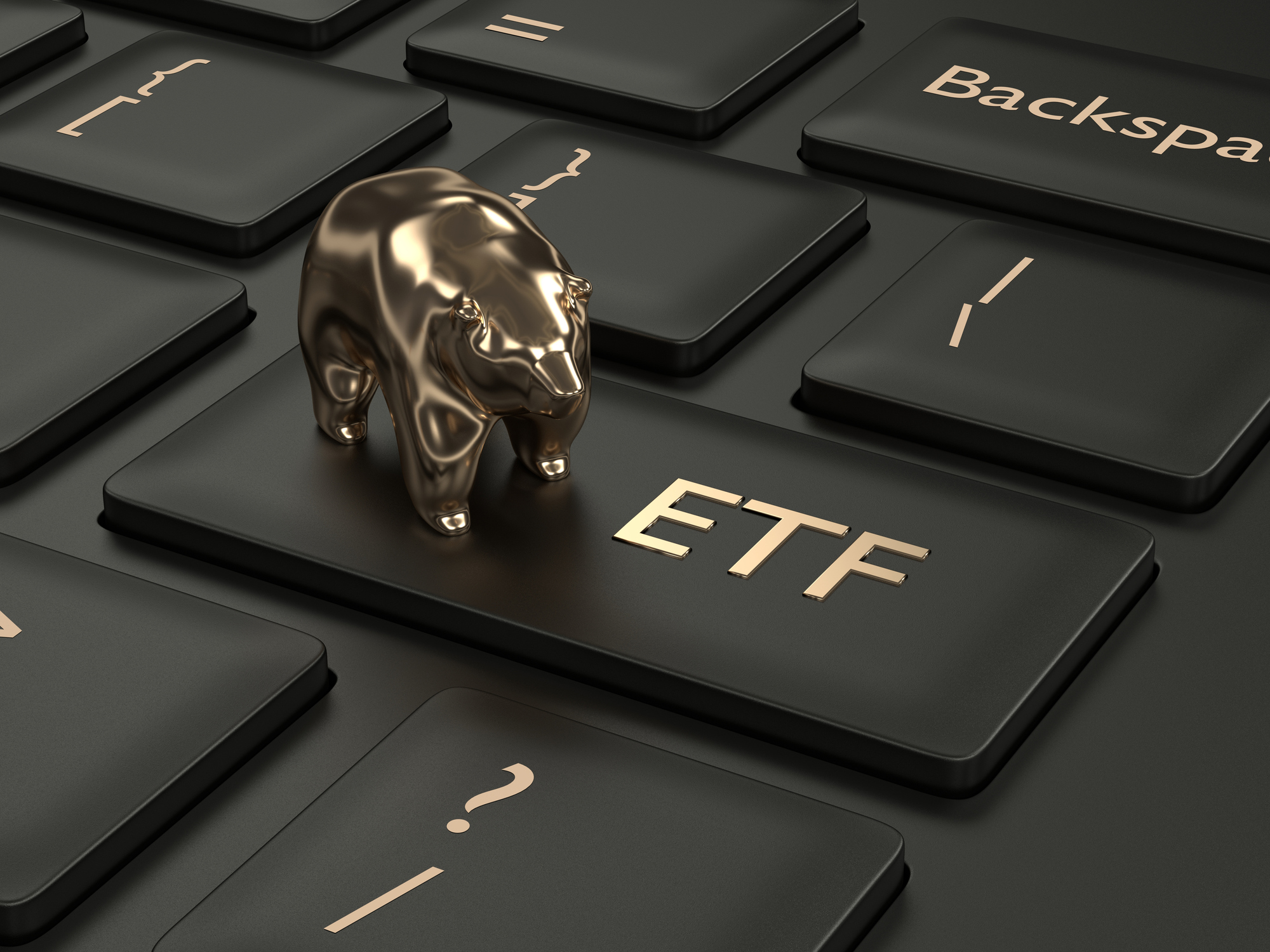What Is an Inverse ETF?
Inverse ETFs can act like insurance for an investor's portfolio, but they're not recommended for everyone. Here's why.


You might have heard of the term "inverse ETFs" in recent years, but what is an inverse ETF and is it something you should consider?
Exchange-traded funds (ETFs) have become one of the most popular products in asset management history – and for good reason. ETFs allow investors the ability to spread risk out over a basket of assets, and typically for very low costs.
Since the first ETF – the SPDR S&P 500 ETF Trust (SPY) – was launched on January 22, 1993, it has grown to be the largest in the world with more than $400.0 billion in net assets.
From just $107.88 $24.99 for Kiplinger Personal Finance
Become a smarter, better informed investor. Subscribe from just $107.88 $24.99, plus get up to 4 Special Issues

Sign up for Kiplinger’s Free Newsletters
Profit and prosper with the best of expert advice on investing, taxes, retirement, personal finance and more - straight to your e-mail.
Profit and prosper with the best of expert advice - straight to your e-mail.
In the past 12 years, ETF assets under management (AUM) in the U.S. and Europe have grown by 15%, compounded annually, to $6.7 trillion through December 31, 2022. ETFs of every theme have launched to meet the voracious appetite of investors.
As a result of this demand, ETFs are expected to account for 24% of total fund assets by 2027, up from 17% today.
One growth area is inverse ETFs, also called bear or short ETFs.
According to data from Morningstar Direct, the worldwide and U.S. inverse ETF AUM as of June 2023 were $103 billion and $80 billion, respectively. In 2022, they saw record net inflows of $28 billion, representing 3.7% of all ETFs purchased last year.
While inverse ETFs are popular with investors, there are three questions those unfamiliar with the product must be able to answer before they dive in.
What is an inverse ETF?
The U.S. Securities and Exchange Commission defines inverse ETFs as funds that seek to deliver a return that is the opposite of the daily performance of a specific index or benchmark tracked by the fund.
Inverse ETFs can track broad-market indexes, specific sectors or other types of benchmarks. The critical thing to remember is that these funds are an inverse bet against the actual direction of that benchmark. For example, if you believe the S&P 500 will fall in value, you profit by purchasing an inverse ETF.
You might be familiar with the concept of shorting a stock, or short-selling, which is the act of borrowing shares from an investor and then selling them in the hope that they fall in value so you can buy them back at a lower price for a profit. Inverse ETFs are similar in that you are betting against a particular investment, profiting from a negative outcome.
Two of the biggest reasons investors buy inverse ETFs are to hedge positions and to take a short-term bearish position in a particular sector, industry or market.
"Inverse ETFs are a tool to hedge a stock portfolio," John DeYonker, head of investor relations at Titan Global Capital Management, states in a 2022 article about these bear funds. "If the S&P 500 is your benchmark, and it goes up 1%, then your hedge will go down 1% and vice versa. Hedging with inverse ETFs can reduce volatility for investors – it's like insurance."
However, they are not for everyone.
How do inverse ETFs work?
To illustrate how inverse ETFs work, we will use the ProShares Short S&P 500 (SH) inverse ETF as a real example. The fund "seeks daily investment results, before fees and expenses, that correspond to the inverse (-1x) of the daily performance of the S&P 500," states the fund's website.
To generate an inverse return from the index's daily performance, it buys derivatives such as swap agreements, futures contracts and money market instruments including U.S. Treasury bills and repurchase agreements.
Fidelity does a good job describing the use of swaps in inverse ETFs:
"A short S&P 500 fund would hold a swap, paying the returns of the index to the counterparty. If the index trades up on any given day, the ETF would have to pay returns on the index to the counterparty, causing the value of the ETF to decrease. If the index trades down, the ETF would be receiving the return of the index, thus driving its net asset value (NAV) higher on the day."
Futures contracts are standardized contracts that obligate the parties to buy or sell an asset at a predetermined price and date in the future. Treasury bills are debt securities issued by the U.S. government with one year or less maturities that pay a fixed interest rate. Lastly, repurchase agreements are agreements where the seller of U.S. government debt securities and other money market instruments agrees to repurchase them at a specific time and price.
Here's what the inverse ETF's prospectus has to say about the process:
"ProShare Advisors [portfolio manager] uses a mathematical approach to investing in which it determines the type, quantity and mix of investment positions that it believes, in combination, the Fund should hold to produce daily returns consistent with the Daily Target. For these purposes a day is measured from the time of one net asset value ("NAV") calculation to the next."
As a result, it rebalances its portfolio daily so that its exposure to the index remains consistent with its daily target. That's a fancy way of saying it rebalances to maintain its inverse return to the index.
Should I buy inverse ETFs?
Unless you are an experienced investor comfortable with significant risk and volatility, inverse ETFs are not recommended for the average retail investor.
They are complicated investments that require considerable work by the portfolio managers to maintain their inverse return. As a result, they are much more expensive than a regular S&P 500 fund. For example, SH charges 0.89%. You can buy a plain vanilla S&P 500 ETF for 0.03%.
Ultimately, ProShares and Direxion, the two biggest ETF providers in the inverse and leveraged space, state that they aren't recommended for buy-and-hold investors.
Word to the wise.
Related content
- Best Defensive ETFs to Protect Your Portfolio
- S&P 500 ETFs: 7 Ways to Play the Index
- What Is an ETF? 9 Things to Know About Exchange-Traded Funds
Profit and prosper with the best of Kiplinger's advice on investing, taxes, retirement, personal finance and much more. Delivered daily. Enter your email in the box and click Sign Me Up.

Will has written professionally for investment and finance publications in both the U.S. and Canada since 2004. A native of Toronto, Canada, his sole objective is to help people become better and more informed investors. Fascinated by how companies make money, he's a keen student of business history. Married and now living in Halifax, Nova Scotia, he's also got an interest in equity and debt crowdfunding.
-
 23 Last-Minute Gifts That Still Arrive Before Christmas
23 Last-Minute Gifts That Still Arrive Before ChristmasScrambling to cross those last few names off your list? Here are 23 last-minute gifts that you can still get in time for Christmas.
-
 The Rule of Compounding: Why Time Is an Investor's Best Friend
The Rule of Compounding: Why Time Is an Investor's Best FriendDescribed as both a "miracle" and a "wonder," compound interest is simply a function of time.
-
 4 Great Tools to DIY Your Own Financial Plan
4 Great Tools to DIY Your Own Financial PlanSmart Savings Several tools picked out by Kiplinger that DIYers can use to make their own financial plan.
-
 Stocks Chop as the Unemployment Rate Jumps: Stock Market Today
Stocks Chop as the Unemployment Rate Jumps: Stock Market TodayNovember job growth was stronger than expected, but sharp losses in October and a rising unemployment rate are worrying market participants.
-
 Stocks Struggle Ahead of November Jobs Report: Stock Market Today
Stocks Struggle Ahead of November Jobs Report: Stock Market TodayOracle and Broadcom continued to fall, while market participants looked ahead to Tuesday's jobs report.
-
 AI Stocks Lead Nasdaq's 398-Point Nosedive: Stock Market Today
AI Stocks Lead Nasdaq's 398-Point Nosedive: Stock Market TodayThe major stock market indexes do not yet reflect the bullish tendencies of sector rotation and broadening participation.
-
 Dow Adds 646 Points, Hits New Highs: Stock Market Today
Dow Adds 646 Points, Hits New Highs: Stock Market TodayIt was "boom" for the Dow but "bust" for the Nasdaq following a December Fed meeting that was less hawkish than expected.
-
 Dow Rises 497 Points on December Rate Cut: Stock Market Today
Dow Rises 497 Points on December Rate Cut: Stock Market TodayThe basic questions for market participants and policymakers remain the same after a widely expected Fed rate cut.
-
 JPMorgan's Drop Drags on the Dow: Stock Market Today
JPMorgan's Drop Drags on the Dow: Stock Market TodaySmall-cap stocks outperformed Tuesday on expectations that the Fed will cut interest rates on Wednesday.
-
 Stocks Slip to Start Fed Week: Stock Market Today
Stocks Slip to Start Fed Week: Stock Market TodayWhile a rate cut is widely expected this week, uncertainty is building around the Fed's future plans for monetary policy.
-
 Stocks Keep Climbing as Fed Meeting Nears: Stock Market Today
Stocks Keep Climbing as Fed Meeting Nears: Stock Market TodayA stale inflation report and improving consumer sentiment did little to shift expectations for a rate cut next week.